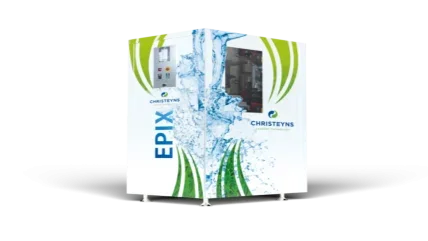
The Ghent, Belgium, multinational Christeyns, which produces detergents and disinfectants for industrial laundries in Belgium and abroad, has launched EPIC, an innovative detergent system. EPIC stands for Enzymatic Process Innovation by Christeyns and is based on enzyme technology, enabling laundries to reduce their waste water costs by 25%.
Alain Bostoen, CEO of Christeyns explained: “Industrial laundries are facing several water challenges: the cost and availability of water, the cost of discharging wastewater and the ever-stricter environmental regulations concerning its discharge. With EPIC, we help laundries meet discharge standards and reduce wastewater costs. Currently, the technology is already being used in more than ten European laundries.”
Surfactants give a detergent its cleaning properties., however, these components have a negative impact on waste water quality. Thanks to the EPIC detergent system, these surfactants are reduced by 50%and supplemented by biological enzymes. This reduces the waste water load by 20-30% thereby providing substantial savings for laundries.
Enzymes have been used in textile care for a long time and have catalytic properties. This means the enzyme acts as an accelerator for certain chemical reactions. So, what makes EPIC so innovative?
Olivier Mareau, application manager and EPIC project manager, explained the process: “EPIC is a flexible detergent system in which the enzyme mixtures are created and dosed according to the stain. These unique mixtures are dosed in the washing process separately from the adapted and enzyme compatible detergent. So, it is not a standard all-in-one detergent. Because we target stains, only a low dose of the mixture is needed for the desired effect.” Christeyns applied for a patent for this unique enzyme mixture at the European patent Office in July last year.
Ecological footprint
Working with enzymes requires expertise. In early 2019, Christeyns’ R&D department and corporate application team started developing the EPIC detergent system. The EPIC mixtures are produced on site at the customer’s premises to be dosed very precisely and safely directly into the wash process. This is done by means of an in-house developed high-tech unit, which was given the name EPIX. Thanks to this EPIX unit, doses from 0.05 grams per kilogram of textile can be dosed. A patent is also pending for this technology.
“Because enzymes have a biological origin and because of the low dosages, you end up with a carbon footprint that is up to 20% lower compared with standard washing processes,” explained Simon Lambert, R&D manager laundry technology. “What’s more, this percentage can increase as the transport of chemical products to customers and their storage can be reduced by 40 to 50%.
Sustainable water management
Polluting water as little as possible and reusing it as much as possible are part of Christeyns’ objectives in the field of sustainable water management. Not only by adapting its chemistry and thus reducing the pollution load of the wastewater, but also by offering the right technology. Also, in that context, the company launched HydRO for laundries last year, through a joint venture with the Belgian company Veride. With this HydRO technology, laundries can reuse at least 80% of their process water.






